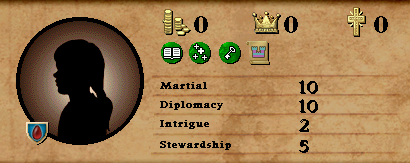
Another forestry (1081)


Published by Narrator on 13.10.07
A new claim (1079)

Published by Narrator on 13.10.07
A heir's marriage (1079)


Published by Narrator on 13.10.07
Crusade! (1078)


Published by Narrator on 12.10.07
Gertrude marries (1076)



Published by Narrator on 12.10.07
A work completed (1075)


Published by Narrator on 12.10.07
The Pope sends a Bishop (1074)



Published by Narrator on 7.10.07
A forestry in Frisia (1074)


Published by Narrator on 7.10.07
A noble warrior (1072)


The Independent Counties' court: almost all positions taken.
Published by Narrator on 7.10.07
Independence! (1070)



Published by Narrator on 7.10.07
A child's upbringing (1068)

 Such a privilege does not come without a cost, however.
Such a privilege does not come without a cost, however.
Published by Narrator on 7.10.07
A Spymaster comes along (1066)


Published by Narrator on 7.10.07
Day One (1066)


Published by Narrator on 6.10.07
The van Braunschweig Family (1066)


 The Count's son is also named Ekbert van Braunschweig. He is 6 years old, and was born in 1060. He is the only male heir to the Counties' throne.
The Count's son is also named Ekbert van Braunschweig. He is 6 years old, and was born in 1060. He is the only male heir to the Counties' throne.Gertrude van Braunschweig, their daughter, is 7 years old. She was born in 1059. When she turns 16, she will be married away for prestige points. It's a family tradition.

Published by Narrator on 6.10.07
The Frisian Counties (1066)


This is the County of Frisia. At a distance, the Hill Fort is the sole reminder of civilization in this sparsely populated, rural province.
The recently built fort provides troop support at a small cost.
Frisia is mostly populated by catholic, dutch peasants. It is a poor county, with an initial base income of 1.20 gold.
Published by Narrator on 6.10.07
About the blog
A CK AAR is a gameplay AAR for Crusader Kings and its expansion Deus Vult. It is inspired in the graphic style of "Knud Knýtling, Prince of Denmark (and other assorted tales)", by phargle, and "Real Men Do It Alphabetically: An AARgau", by anonymous4401, both published in the Paradox Interactive Forums.
The present AAR is to be the first episode in a mega-campaign aimed to spread from CK to Europa Universalis, Victoria and Hearts of Iron. No modifications have been included, and the default game settings for difficulty and AI aggressiveness are being used. The story begins from the Hastings scenario, in 1066.
Published by Narrator on 6.10.07





